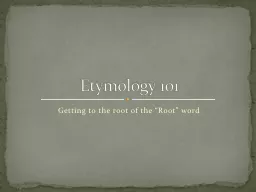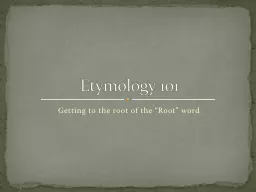PPT-Getting to the root of the “Root” word
Author : enjoinsamsung | Published Date : 2020-06-17
Etymology 101 What Did Europeans Create THE ONLY THINGS IN LANGUAGE AND CULTURE THE EUROPEANS CREATED WERE THE DISTORATION THE LIE THE HIDDEN INFORMATION Etymology
Presentation Embed Code
Download Presentation
Download Presentation The PPT/PDF document "Getting to the root of the “Root” wo..." is the property of its rightful owner. Permission is granted to download and print the materials on this website for personal, non-commercial use only, and to display it on your personal computer provided you do not modify the materials and that you retain all copyright notices contained in the materials. By downloading content from our website, you accept the terms of this agreement.
Getting to the root of the “Root” word: Transcript
Download Rules Of Document
"Getting to the root of the “Root” word"The content belongs to its owner. You may download and print it for personal use, without modification, and keep all copyright notices. By downloading, you agree to these terms.
Related Documents












![[DOWNLOAD] - Med School Rx: Getting In, Getting Through, and Getting On with Doctoring](https://thumbs.docslides.com/902921/download-med-school-rx-getting-in-getting-through-and-getting-on-with-doctoring.jpg)
![[EBOOK] - Med School Rx: Getting In, Getting Through, and Getting On with Doctoring](https://thumbs.docslides.com/906464/ebook-med-school-rx-getting-in-getting-through-and-getting-on-with-doctoring.jpg)
